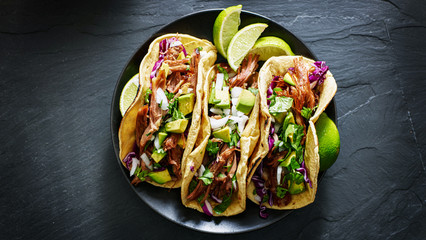Space City Birria Tacos and More are a beloved Mexican dish consisting of a warmed tortilla folded around various fillings. The possibilities are endless, and they can be topped with delicious garnishes like sour cream, guacamole, and cilantro.
The origin of tacos is a bit of a mystery, but they probably came about as part of the packable meals for 18th-century silver miners. The term “taco” was slang for the paper they wrapped around gunpowder to insert into holes they carved in the rocks.
The origins of tacos are a bit of an enigma. Various scholars propose different theories, but no one knows for sure. The most common theory is that the taco was developed from the ancient practice of nixtamal, which involves boiling corn to create a pliable dough. It can then be used to wrap a variety of ingredients. Several ancient civilizations used tortillas, but the Aztecs are considered to have perfected the process of preparing corn for making this hand-held treat. Moctezuma, the ninth Aztec emperor, is known to have enjoyed his food using these tortillas as spoons. It is also thought that Hernan Cortes served his soldiers meals made of tortillas and pork after conquering the Aztec empire.
The first documented use of the term “taco” dates back to the 18th century, when it referred to the silver mines in Mexico. Miners called the small charges they inserted into holes in the rock tacos. The taquito, a rolled taco, is also thought to have originated in the mines. This is because it closely resembles the shape of sticks of dynamite, which were used to excavate ore in the mines.
As industrialization swept the country, Mexicans moved to the large cities where they could find work. Women began setting up taquerias, where they would cook food in the style of their original regions. This is one reason that tacos have so many varieties.
Tacos spread throughout the United States with the help of Mexican migrants. They brought their love of this dish to a new audience and began to modify it to suit American tastes. This included substituting hamburger meat and shredded cheese for traditional Mexican ingredients.
Variations
While some people might think of tacos as a stereotypical Mexican dish, they are actually quite varied. From meaty carnitas to crunchy nopales, there is a taco for every taste. You can even enjoy a vegetarian version by swapping out beef for beans or a tasty shredded cabbage slaw. Then there are the sauces and salsa, which tie everything together. Whether it’s tangy pico de gallo or creamy guacamole, there is a salsa to match every filling.
At its core, a taco is a small tortilla that wraps or folds around a filling, typically meaty. The shell can be made from either corn or flour, and it can be soft or crunchy. The fillings are typically accompanied by salsa, sour cream and cheese, although some people also include cilantro, radish or lime slices.
As a result of the variety of ingredients that Mexico has to offer, tacos have evolved into many different varieties. For example, Lebanese immigrants brought over the dish of shawarma to Mexico, where it was adapted into al pastor tacos using succulent pork shoulder instead of lamb. It’s also often garnished with pineapple, which provides a refreshing contrast to the pork’s salt, oregano and cumin-based spices.
Birria is another taco variation that originates from Jalisco. It uses goat meat that has been stewed in a red chilli and achiote (made from the roasted skins of the annatto seeds) sauce. It can be served with a variety of toppings, from the traditional to the more adventurous, such as sliced raw onion and coriander or spicy mango salsa. Then there are the tacos campechanos, which combine a range of meats such as carne asada and longaniza with chorizo and chicarron for a balanced and complex-in-flavor medley of flavours.
Fillings
As with their cousins, fajitas and burritos, tacos come in many forms, with both soft and crunchy shells, and can be filled with a variety of meats, fish, vegetables and other fillings. They also offer an opportunity to explore different flavours and cuisines, with recipes including gyro meat, American barbecue and Korean bulgogi.
Toppings like shredded cheese, salsa and guacamole can add a range of textures and colours to your tacos. Choose from fresh or jarred options, and vary the heat with hot sauces such as salsa verde and jalapeno salsa. For a delicious twist on guacamole, try mashing avocado with coriander, lime juice and salt, or mix it into a creamy queso dip.
While most tacos contain a meat base, there are many vegetarian versions that are equally delicious and satisfying. Roasted veggies, like peppers, carrots and zucchini, are a popular choice, or you can make fish tacos with light beer batter for a crisp coating, or go all-out with a birria taco, stuffed poblanos in a rich consomme.
Having a range of fillings to choose from is also a great way to get kids involved in cooking, and can encourage them to eat healthy foods they might otherwise avoid. For example, this recipe uses small (not baby!) carrots roasted with fragrant cumin seeds to fill homemade tortillas with juicy skirt steak and a tart cabbage slaw.
It’s worth remembering that the taco shell itself can also contribute to a dish’s flavour, with both corn and flour versions available. The trick is to heat them before filling, so they become a bit softer and blend in better with the other ingredients. For a fun do-it-yourself meal, set out a plate of warm tortillas with the suggested fillings and toppings for each diner to create their own edible masterpiece.
Toppings
Tacos are a great way to serve up a delicious and fun meal, especially for parties. They can be eaten on a single tortilla or in a taco shell. They can be topped with different fillings and toppings to create a unique and tasty meal. They can also be served with different sauces or salsas for added flavor. Tacos are a good choice for any occasion, including game day get-togethers, birthday parties, and intimate weddings.
Some traditional taco toppings include chopped onions, cilantro, and sliced bell peppers. Cilantro is an essential ingredient in Mexican cuisine and adds a fresh and herbaceous flavor to tacos. Bell peppers provide a crunch and are available in a variety of colors, from green to red and yellow.
Another popular taco topping is cheese. Shredded blends like cheddar and pepper jack melt nicely, while crumbled cotija and Oaxaca add a bit of a spicy kick. Other options are salsa and guacamole. Salsa and guacamole are versatile, offering a wide range of flavors to suit any palate. They can be as mild or as spicy as desired, and can be made using fresh or jarred ingredients.
Beans and shredded carrots are other nutritious toppings that can be added to tacos. They are high in fiber and protein, and provide a hearty base for other fillings. Carrots are high in antioxidants and can be added for a sweet and crunchy twist to tacos.
Other interesting and creative taco toppings include shredded lettuce, cabbage (red or green), baby spinach, and other salad greens. Cauliflower is also becoming a popular vegetable for tacos. Its nutty and subtle sweetness helps balance the spices and other fillings in the taco. It is also a good alternative for those who do not eat meat, as it can be stuffed with other vegetables or shredded chicken.
Healthy options
Adding some vegetables and substituting sour cream and cheese with healthy ingredients can make tacos nutritious. But be careful not to overdo it on the condiments because they can add a lot of calories and fat. When eating tacos at restaurants, stick with ones that are grilled rather than fried and try to avoid those with a lot of added salt and fat.
Using lower-sodium taco seasoning, or making your own, is a simple way to reduce the sodium in your meal. And opting for a low-fat or non-fat sour cream can reduce the amount of saturated fat you consume.
If you’re a meat-eater, try lean proteins like chicken or ground turkey. And if you’re a vegetarian, look for recipes that use beans or other plant-based fillings. Beans provide a good source of protein and fiber, while tofu provides plant-based protein and plenty of iron.
Nutrient-rich veggies, like shredded kale and sweet potatoes, are great taco fillings. These veggies are also high in vitamin A, which plays a role in eye health and immune function. And don’t forget to include a fruit, like mango or pineapple, for a burst of sweetness and potassium. Avocado is another delicious and nutritious option for a taco. It’s rich in potassium, vitamin K and a healthy monounsaturated fat. And when choosing guacamole, check that it doesn’t contain too much saturated fat or a lot of sugar.



